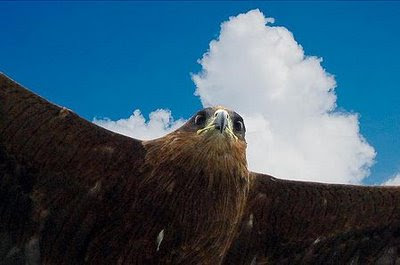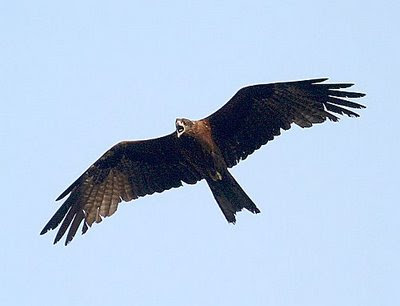The Fork-Tailed Black Kite is commonly found at Tiruvannamalai, and is particularly noticeable flying in the thermals around Arunachala. The Tamil name for this bird is Kalu Parandu.
The nest of the Fork-Tailed Black Kite is usually an untidy platform of twigs, rags, wire and all sorts of rubbish. The nest is commonly located in a large tree, roof, or cornice of a building. Two or four eggs are laid in a batch.
The nest of the Fork-Tailed Black Kite is usually an untidy platform of twigs, rags, wire and all sorts of rubbish. The nest is commonly located in a large tree, roof, or cornice of a building. Two or four eggs are laid in a batch.

Both sexes share in domestic duties.

In the below photograph a juvenile bird is practising his flying action.

The Fork-Tailed Black Kite is India's commonest raptor and is usually found in the neighbourhood of human habitations, whether a populated city or outlying village.

This Kite (Milvus migrans) is a medium-sized bird of prey in the family Accipitridae which also includes many other diurnal raptors such as eagles, buzzards, and harriers. It is about the size of a vulture.

The Kite will take small live prey as well as fish, household refuse and carrion. They are attracted to fires and smoke where they seek escaping insect prey. They are well adapted to living in cities and are found even in densely populated areas. Large numbers may be seen soaring in thermals over cities. In some places they will readily swoop to take to food offered by humans.

Differences between Raptor birds:
Kite - Any of several small graceful Hawks of the family Accipitridae having long pointed wings and feeding on insects and small animals
Eagle - Any of various large keen-sighted diurnal birds of prey noted for their broad wings and strong soaring flight
Hawk - Diurnal bird of prey typically having short rounded wings and a long tail
Falcon - Diurnal birds of prey having long pointed powerful wings adapted for swift flight

The Fork-Tailed Black Hawk is a very accomplished flier; turning and twisting, banking and stooping to scoop up scraps from the roadside and easily avoiding overhead telephone and electric wires.

No comments:
Post a Comment